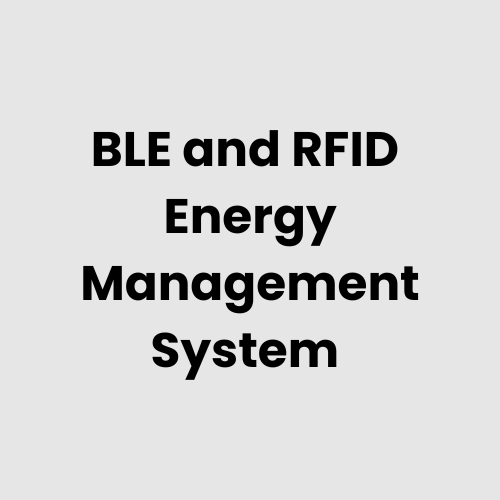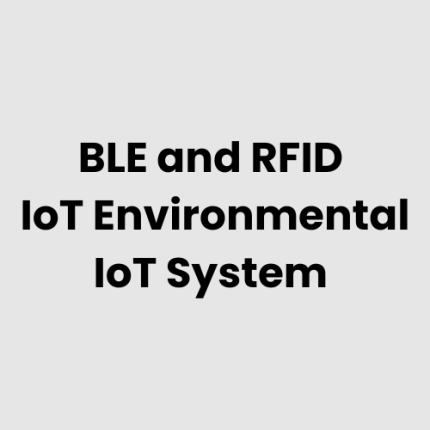Description
Technical Architecture of BLE and RFID IoT Enabled Energy Management System
The BLE and RFID IoT Enabled Energy Management System from GAO Tek Inc. integrates advanced IoT technologies such as BLE (Bluetooth Low Energy) and RFID to provide real-time energy monitoring and management solutions. The system typically consists of the following layers:
- Sensor Layer:
BLE sensors and RFID tags are deployed across various devices (smart meters, HVAC systems, lighting, etc.) for continuous data collection on energy consumption, temperature, and system status. - Communication Layer:
The data collected from BLE sensors and RFID tags is transmitted to a central gateway through wireless communication protocols, including Bluetooth and Wi-Fi. This layer ensures seamless data transfer with low energy consumption. - Data Processing Layer:
The gateway processes the data before sending it to either a local server or cloud platform. This layer is responsible for filtering and aggregating raw data into actionable insights. - Application Layer:
The system includes software interfaces for users to access real-time analytics, trends, and alerts related to energy consumption. This layer is responsible for data visualization and generating reports on energy optimization. - Management Layer:
The backend management system handles the configuration, administration, and control of connected devices. It ensures seamless system updates and device interoperability within the energy management network
Hardware of BLE and RFID IoT Enabled Energy Management System
The core hardware components of the BLE and RFID IoT Enabled Energy Management System are designed to optimize energy management. Key hardware includes:
- BLE Sensors:
Low-energy sensors deployed across the building infrastructure to measure energy consumption, temperature, and humidity. - RFID Tags:
RFID tags attached to critical assets like energy meters, power distribution units, and HVAC systems to track their operational status and provide asset management data. - Gateways:
These devices aggregate and transmit data from sensors and tags to a central server. They communicate via Bluetooth, Wi-Fi, or cellular networks. - Energy Meters:
Smart energy meters with BLE or RFID interfaces that monitor energy consumption and transmit data to the central system. - Servers (Local or Cloud-based):
Servers for data storage and processing, either on-site or through a cloud service, to ensure that the system’s data is safely stored and accessible for analytics.
Physical Placement Considerations of the Hardware
When deploying the BLE and RFID IoT Enabled Energy Management System, careful planning of hardware placement is crucial for system performance:
- Sensors:
Place BLE sensors on energy-consuming devices such as lights, HVAC units, and appliances, ensuring they are within BLE range for reliable data transmission. - RFID Tags:
RFID tags should be placed on key assets like electrical meters and transformers. Ensure proper line-of-sight for RFID readers to capture data accurately. - Gateways:
Position gateways centrally within the network to ensure strong and consistent wireless communication with all BLE devices and RFID tags. - Energy Meters:
Install energy meters at main entry points or critical junctures in the building or facility to monitor overall energy consumption efficiently.
Hardware Architecture of BLE and RFID IoT Enabled Energy Management System
The hardware architecture of the BLE and RFID IoT Enabled Energy Management System is designed for scalability and reliability. It generally consists of:
- Energy Consumption Devices (e.g., lights, HVAC units, machinery) outfitted with BLE sensors to track their performance.
- RFID-enabled Energy Meters that communicate data such as consumption readings and system status.
- Gateways that connect local devices (BLE sensors, RFID tags) to the cloud or local server. These devices may use Bluetooth or Wi-Fi for communication.
- Local or Cloud Servers that store, process, and analyze the energy usage data, which can be accessed by users through dashboards and reports.
This architecture ensures seamless data flow from the energy devices through to the cloud or local servers, enabling real-time monitoring, control, and optimization of energy consumption.
Deployment Considerations of BLE and RFID IoT Enabled Energy Management System
For the successful deployment of the BLE and RFID IoT Enabled Energy Management System, GAO Tek Inc. suggests the following considerations:
- Network Coverage:
Ensure that the wireless network covers all required areas for BLE devices to function without disruption, particularly in large or multi-floor facilities. - Security:
Implement encryption protocols for data transmission between BLE sensors, RFID readers, and servers to safeguard sensitive energy data. - Scalability:
Design the deployment with future expansion in mind, as more devices or sensors may be added as the system grows. - Power Supply:
Verify a reliable power supply for all system components, particularly sensors and gateways that may operate in remote or hard-to-reach areas. - Maintenance:
Schedule regular maintenance for devices, particularly for battery-powered sensors and energy meters, to ensure continued operation and data integrity.
List of Relevant Industry Standards and Regulations
- IEC 61850 – Communication networks and systems in substations
- ISO/IEC 27001 – Information security management
- IEEE 802.15.1 – Bluetooth standards
- EN 62056 – Energy Metering communication protocols
- NIST SP 800-53 – Security and privacy controls for federal information systems
- IEC 62056 – Data exchange for meter reading
- ANSI C12.19 – Data tables for utility meters
- EN 13757 – Meter reading systems
- UL 294 – Access control systems
- ISO 50001 – Energy management systems
Local Server Version of BLE and RFID IoT Enabled Energy Management System
For on-premises installations, the BLE and RFID IoT Enabled Energy Management System can be configured to run with a local server. The server stores and processes energy data, allowing for real-time analysis and local reporting. A local server-based system ensures high-speed performance and enhanced data security by keeping sensitive information within the facility’s network. GAO Tek can help design and implement the server infrastructure, ensuring seamless integration with existing IT systems.
Cloud Integration and Data Management
The cloud integration of the BLE and RFID IoT Enabled Energy Management System facilitates centralized monitoring, control, and data storage. Through the cloud, energy consumption data from across multiple locations can be accessed in real-time, enabling improved decision-making and resource management. Cloud platforms also offer scalability for data storage, backup, and disaster recovery.
Data management is performed with powerful analytics tools to identify energy inefficiencies and generate actionable insights. Through machine learning algorithms, predictive maintenance can be employed, helping to reduce operational costs and improve overall energy efficiency. GAO Tek provides expert guidance in choosing and integrating the best cloud solutions for your system’s requirements.
By leveraging our expertise, GAO Tek Inc. ensures the BLE and RFID IoT Enabled Energy Management System is deployed in a manner that aligns with your specific energy management needs while maintaining system scalability, security, and performance.
GAO Case Studies of BLE and RFID IoT Enabled Energy Management System
Case Studies in the USA
- Chicago, Illinois
A manufacturing plant in Chicago utilized BLE sensors and RFID tags to monitor energy consumption across production lines. With GAO Tek’s assistance, the system improved energy efficiency by 20%. The deployment followed standards outlined by NIST to ensure compliance with federal guidelines on IoT security and interoperability. - New York City, New York
A commercial office in New York City integrated BLE-enabled smart meters for precise energy monitoring. RFID tags were installed on HVAC systems to track maintenance schedules. The solution complied with the U.S. Department of Energy recommendations for energy-efficient building designs. - Austin, Texas
A smart campus project in Austin deployed BLE-based energy meters and RFID sensors for real-time power usage monitoring. The implementation leveraged guidelines from the International Energy Agency on energy sustainability. GAO Tek designed and implemented the custom hardware for this project. - Seattle, Washington
In Seattle, a logistics company equipped its distribution facility with BLE sensors to monitor lighting energy usage. RFID tags were used for equipment tracking. GAO Tek’s solution adhered to IEEE standards for IoT-enabled infrastructure. - Boston, Massachusetts
A research lab in Boston implemented a BLE and RFID IoT energy management system to monitor lab equipment’s energy usage. The solution complied with energy efficiency goals outlined by ENERGY STAR. - San Francisco, California
A tech startup in San Francisco implemented BLE energy sensors and RFID tags to reduce power consumption in its data center. The system followed recommendations by the California Energy Commission. - Denver, Colorado
A public library in Denver introduced RFID-enabled HVAC systems integrated with BLE sensors to manage power usage dynamically. GAO Tek’s solution met requirements from the American Council for an Energy-Efficient Economy. - Miami, Florida
A high-rise residential complex in Miami adopted BLE and RFID IoT systems for centralized energy management. The deployment followed best practices defined by the Building Owners and Managers Association. - Phoenix, Arizona
A solar power facility in Phoenix integrated BLE-enabled smart meters and RFID tags for asset tracking and energy management. The project followed standards from the Solar Energy Industries Association. - Detroit, Michigan
A car manufacturing plant in Detroit used BLE sensors for energy monitoring across assembly lines and RFID tags for equipment tracking. The system complied with ANSI standards for industrial IoT applications. - Las Vegas, Nevada
A casino in Las Vegas deployed BLE energy meters to monitor lighting and HVAC systems. GAO Tek provided hardware adhering to ASHRAE guidelines for energy-efficient buildings. - Portland, Oregon
A green office building in Portland utilized BLE and RFID to optimize its energy management. GAO Tek’s implementation aligned with the Green Building Council’s LEED standards. - Philadelphia, Pennsylvania
A hospital in Philadelphia introduced RFID-based energy tracking for medical equipment, combined with BLE-enabled HVAC systems. This solution followed energy-saving practices outlined by the Healthcare Environmental Resource Center. - Atlanta, Georgia
An educational institution in Atlanta implemented BLE sensors and RFID tags for campus-wide energy tracking. The deployment followed DOE guidelines for energy management in academic buildings. - Houston, Texas
An oil and gas company in Houston adopted BLE and RFID IoT systems to manage energy usage at its processing facility. GAO Tek ensured the system adhered to standards from the American Petroleum Institute.
Case Studies in Canada
- Toronto, Ontario
In Toronto, a municipal building implemented BLE-enabled energy meters and RFID asset trackers to reduce operational energy costs. GAO Tek’s solution met guidelines from Natural Resources Canada. - Vancouver, British Columbia
A sustainable housing project in Vancouver utilized BLE sensors for real-time energy monitoring and RFID tags for asset management. The project complied with CSA Group standards for energy efficiency.
Navigation Menu for BLE and RFID IoT
Navigation Menu for IoT
- LORAWAN
- Wi-Fi HaLow
- Z-WAVE
- BLE & RFID
- NB-IOT
- CELLULAR IOT
- GPS IOT
- IOT SENSORS
- EDGE COMPUTING
- IOT SYSTEMS
Our products are in stock and can be shipped to anywhere in continental U.S. or Canada from our local warehouse. To purchase or for any further information, please fill out this form or email us.
We are actively looking for partners who are like us located in the U.S. and Canada. For more information on partnering with GAO, please visit Partner with GAO Tek Inc. It lists various ways to partner with GAO, such as OEM Partnerships, Technology Integration, Distribution and Reselling Opportunities, Presenting at the Leading Event Tek Summit, Joint R&D Projects, Training and Consulting Services, Industry-Specific Collaborations, Research and Academic Partnerships.



